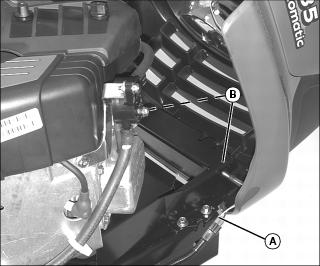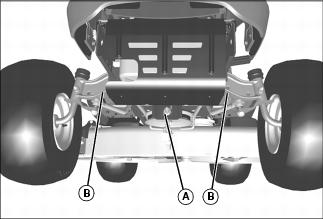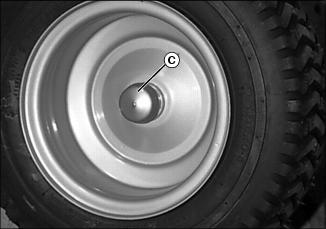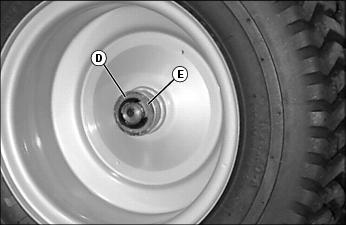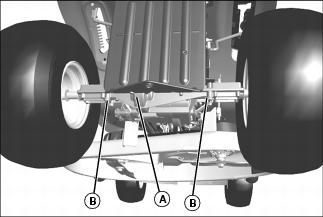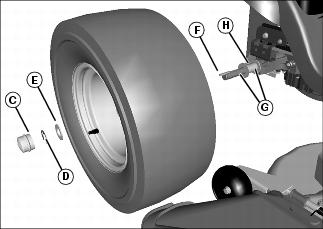
Service Miscellaneous
Using Proper Fuel
Use regular grade unleaded fuel with an octane rating of 87 octane or higher. Fuel blends containing up to 10% ethanol or up to 15% MTBE reformulated fuel are acceptable. Do not use fuel or additives containing methanol as engine damage can occur.
Always use fresh, clean fuel that is purchased in a quantity that can be used within approximately 30 days, or add fuel stabilizer.
Fuel is blended to give best seasonal performance. To avoid engine performance problems such as hard starting or vapor lock, use in-season fuel. Use fuel during warm weather that was purchased during that season, and use fuel during cold weather that was purchased during that season.
Fuel can become stale in machines with engines that are used seasonally or infrequently during a season. Stale fuel can produce varnish and plug carburetor components which can affect engine performance.
Keep fuel storage container tightly covered and in a cool area out of direct sunlight. Fuel can break down and degrade if not sealed properly or exposed to sun and heat.
Condensation may collect in the fuel tank because of a variety of operating or environmental conditions and, over time, may affect your machine’s operation. Fill fuel tank at the end of daily use and store fuel in plastic containers to reduce condensation.
For best year-round performance and fuel-handling, add stabilizer to fuel immediately after fuel purchase. Such practice helps prevent engine performance problems and allows fuel storage in the machine all year without draining.
Filling Fuel Tank
Fill fuel tank at the end of each day’s operation to prevent condensation and freezing during cold weather.
1. Park machine safely. (See Parking Safely in the SAFETY section.)
3. Remove any trash from area around fuel tank cap.
4. Remove fuel tank cap slowly to allow any pressure built up in tank to escape.
5. Fill fuel tank only to bottom of filler neck.
Checking Tire Pressure
2. Check tire pressure with an accurate gauge.
3. Service tires safely. (See Tire Safety in the SAFETY section.)
4. Check that tires have equal air pressure. Add or remove air, if necessary.
5. Refer to side of tire for correct tire inflation pressure.
Removing and Installing Hood
Removing
IMPORTANT: Avoid damage! Do not operate machine with hood open. Hood must be closed for proper engine cooling and exhaust. |
1. Park machine safely. (See Parking Safely in the SAFETY section.)
4. Disconnect wiring harness (A).
5. Lower hood slightly and lift hood from brackets (B).
Installing
1. Align hood brackets with tractor brackets and install hood.
Cleaning Plastic Surfaces
1. Rinse hood and entire machine with clean water to remove dirt and dust that may scratch the surface.
2. Wash surface with clean water and a mild liquid automotive washing soap.
3. Dry thoroughly to avoid water spots.
4. Wax the surface with a liquid automotive wax. Use products that specifically say “contains no abrasives.”
5. Buff applied wax by hand using a clean, soft cloth.
Cleaning and Repairing Metal Surfaces
Cleaning:
Follow automotive practices to care for your vehicle painted metal surfaces. Use a high-quality automotive wax regularly to maintain the factory look of your vehicle’s painted surfaces.
Repairing Minor Scratches (surface scratch):
1. Clean area to be repaired thoroughly.
2. Use automotive polishing compound to remove surface scratches.
3. Apply wax to entire surface.
Repairing Deep Scratches (bare metal or primer showing):
1. Clean area to be repaired with rubbing alcohol or mineral spirits.
2. Use paint stick with factory-matched colors available from your authorized dealer to fill scratches. Follow directions included on paint stick for use and for drying.
3. Smooth out surface using an automotive polishing compound. Do not use power buffer.
Removing and Installing Front Wheel Assembly
Removing:
1. Park machine safely. (See Parking Safely in the SAFETY section.)
IMPORTANT: Avoid damage! Place jack stands under frame, not under transmission or engine, when raising or supporting machine. |
2. Safely lift and support machine. Place safe lifting device under end of front hanger bracket at location (A), and place jack stands or other stable supports under frame on each side at location (B). Block wheels remaining on the ground to prevent machine movement.
3. Remove plastic cap (C) from end of wheel hub.
4. Remove snap ring (D) from end of axle.
5. Remove washer (E) and wheel from axle.
6. Take wheel assembly to an authorized service dealer for repairs.
Installing
1. Grease spindles and wheel hub grease fittings with specified grease.
2. Install wheel and washer (E) on axle.
5. Safely remove jack stands and lower machine.
Removing and Installing Rear Wheel Assembly
Removing
1. Park machine safely. (See Parking Safely in the SAFETY section.)
IMPORTANT: Avoid damage! Place jack stands under frame, not under transmission or engine, when raising or supporting machine. |
2. Safely lift and support machine. Place safe lifting device under transmission centered under machine at location (A). Place jack stands or other stable supports on each side (B) where mounting bolts for frame come through. Block wheels remaining on the ground to prevent machine movement.
3. Remove plastic cap (C), snap ring (D), and washer (E).
IMPORTANT: Avoid damage! Do not lose the shaft key. Key must be installed for wheels to rotate and tractor to move. |
5. Remove shaft key (F) (shown on end of transaxle shaft), two washers (G) and spacer (H).
6. Take wheel assembly to an authorized service dealer for repairs.
Installing
IMPORTANT: Avoid damage! Do not lose the shaft key. Key must be installed for wheels to rotate and tractor to move. |
NOTE: Rear wheels are installed with valves to the outside.
1. Install two washers (G), spacer (H), and shaft key (F).
2. Install rear wheel, washer (E), snap ring (D) and plastic cap (C).
